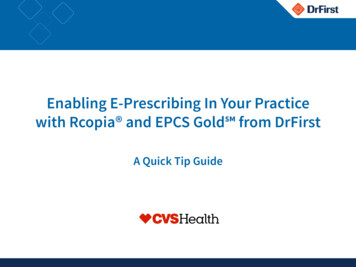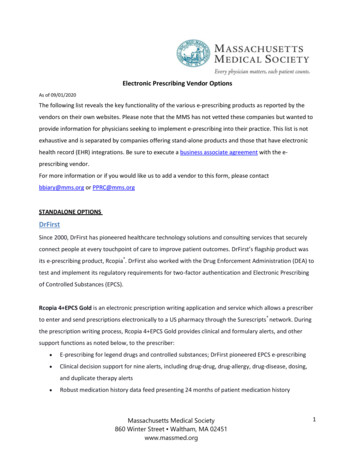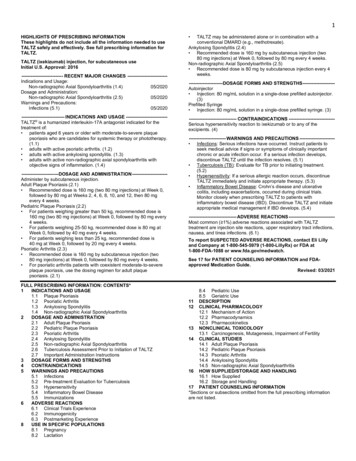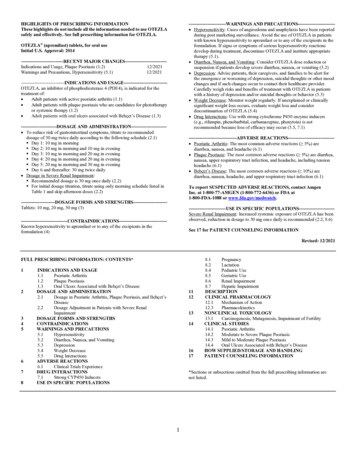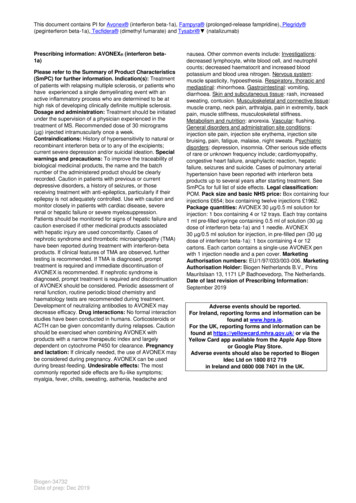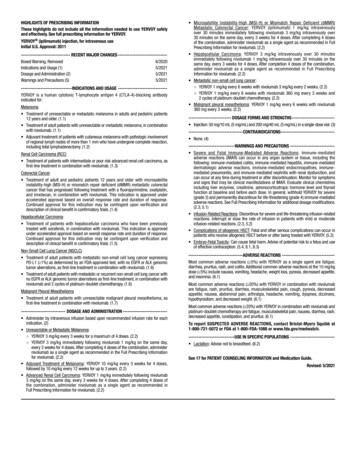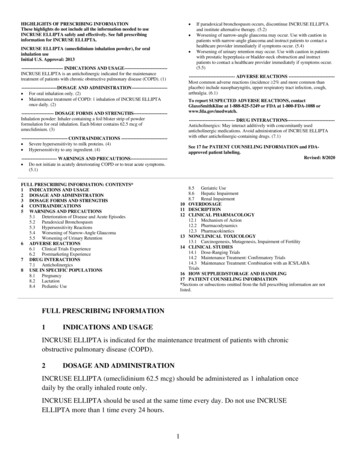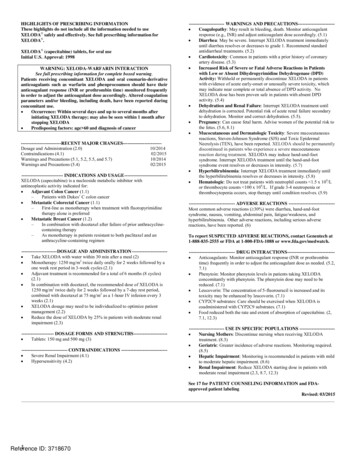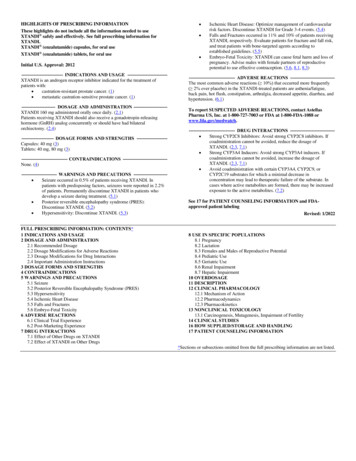
Transcription
HIGHLIGHTS OF PRESCRIBING INFORMATIONThese highlights do not include all the information needed to useXTANDI safely and effectively. See full prescribing information forXTANDI.XTANDI (enzalutamide) capsules, for oral useXTANDI (enzalutamide) tablets, for oral useInitial U.S. Approval: 2012--------------------------- INDICATIONS AND USAGE -------------------------XTANDI is an androgen receptor inhibitor indicated for the treatment ofpatients with: castration-resistant prostate cancer. (1) metastatic castration-sensitive prostate cancer. (1)---------------------- DOSAGE AND ADMINISTRATION ---------------------XTANDI 160 mg administered orally once daily. (2.1)Patients receiving XTANDI should also receive a gonadotropin-releasinghormone (GnRH) analog concurrently or should have had bilateralorchiectomy. (2.4)--------------------- DOSAGE FORMS AND STRENGTHS -------------------Capsules: 40 mg (3)Tablets: 40 mg, 80 mg (3)------------------------------ CONTRAINDICATIONS ----------------------------None. (4)----------------------- WARNINGS AND PRECAUTIONS --------------------- Seizure occurred in 0.5% of patients receiving XTANDI. Inpatients with predisposing factors, seizures were reported in 2.2%of patients. Permanently discontinue XTANDI in patients whodevelop a seizure during treatment. (5.1) Posterior reversible encephalopathy syndrome (PRES):Discontinue XTANDI. (5.2) Hypersensitivity: Discontinue XTANDI. (5.3)FULL PRESCRIBING INFORMATION: CONTENTS*1 INDICATIONS AND USAGE2 DOSAGE AND ADMINISTRATION2.1 Recommended Dosage2.2 Dosage Modifications for Adverse Reactions2.3 Dosage Modifications for Drug Interactions2.4 Important Administration Instructions3 DOSAGE FORMS AND STRENGTHS4 CONTRAINDICATIONS5 WARNINGS AND PRECAUTIONS5.1 Seizure5.2 Posterior Reversible Encephalopathy Syndrome (PRES)5.3 Hypersensitivity5.4 Ischemic Heart Disease5.5 Falls and Fractures5.6 Embryo-Fetal Toxicity6 ADVERSE REACTIONS6.1 Clinical Trial Experience6.2 Post-Marketing Experience7 DRUG INTERACTIONS7.1 Effect of Other Drugs on XTANDI7.2 Effect of XTANDI on Other Drugs Ischemic Heart Disease: Optimize management of cardiovascularrisk factors. Discontinue XTANDI for Grade 3-4 events. (5.4)Falls and Fractures occurred in 11% and 10% of patients receivingXTANDI, respectively. Evaluate patients for fracture and fall risk,and treat patients with bone-targeted agents according toestablished guidelines. (5.5)Embryo-Fetal Toxicity: XTANDI can cause fetal harm and loss ofpregnancy. Advise males with female partners of reproductivepotential to use effective contraception. (5.6, 8.1, 8.3)------------------------------ ADVERSE REACTIONS ----------------------------The most common adverse reactions ( 10%) that occurred more frequently( 2% over placebo) in the XTANDI-treated patients are asthenia/fatigue,back pain, hot flush, constipation, arthralgia, decreased appetite, diarrhea, andhypertension. (6.1)To report SUSPECTED ADVERSE REACTIONS, contact AstellasPharma US, Inc. at 1-800-727-7003 or FDA at 1-800-FDA-1088 --- DRUG INTERACTIONS ---------------------------- Strong CYP2C8 Inhibitors: Avoid strong CYP2C8 inhibitors. Ifcoadministration cannot be avoided, reduce the dosage ofXTANDI. (2.3, 7.1) Strong CYP3A4 Inducers: Avoid strong CYP3A4 inducers. Ifcoadministration cannot be avoided, increase the dosage ofXTANDI. (2.3, 7.1) Avoid coadministration with certain CYP3A4, CYP2C9, orCYP2C19 substrates for which a minimal decrease inconcentration may lead to therapeutic failure of the substrate. Incases where active metabolites are formed, there may be increasedexposure to the active metabolites. (7.2)See 17 for PATIENT COUNSELING INFORMATION and FDAapproved patient labelingRevised: 1/20228 USE IN SPECIFIC POPULATIONS8.1 Pregnancy8.2 Lactation8.3 Females and Males of Reproductive Potential8.4 Pediatric Use8.5 Geriatric Use8.6 Renal Impairment8.7 Hepatic Impairment10 OVERDOSAGE11 DESCRIPTION12 CLINICAL PHARMACOLOGY12.1 Mechanism of Action12.2 Pharmacodynamics12.3 Pharmacokinetics13 NONCLINICAL TOXICOLOGY13.1 Carcinogenesis, Mutagenesis, Impairment of Fertility14 CLINICAL STUDIES16 HOW SUPPLIED/STORAGE AND HANDLING17 PATIENT COUNSELING INFORMATION*Sections or subsections omitted from the full prescribing information are not listed.
FULL PRESCRIBING INFORMATION1INDICATIONS AND USAGEXTANDI is indicated for the treatment of patients with: castration-resistant prostate cancer (CRPC)metastatic castration-sensitive prostate cancer (mCSPC)2DOSAGE AND ADMINISTRATION2.1Recommended DosageThe recommended dosage of XTANDI is 160 mg administered orally once daily with or without food [see ClinicalPharmacology (12.3)]. Swallow capsules or tablets whole. Do not chew, dissolve, or open the capsules. Do not cut, crush,or chew the tablets.2.2Dosage Modifications for Adverse ReactionsIf a patient experiences a Grade 3 or an intolerable adverse reaction, withhold XTANDI for one week or until symptomsimprove to Grade 2, then resume at the same or a reduced dose (120 mg or 80 mg) if warranted [see Warnings andPrecautions (5.1, 5.2)].2.3Dosage Modifications for Drug InteractionsStrong CYP2C8 InhibitorsAvoid the coadministration of strong CYP2C8 inhibitors. If the coadministration of a strong CYP2C8 inhibitor cannot beavoided, reduce the XTANDI dosage to 80 mg once daily. If the coadministration of the strong inhibitor is discontinued,increase the XTANDI dosage to the dosage used prior to initiation of the strong CYP2C8 inhibitor [see ClinicalPharmacology (12.3)].Strong CYP3A4 InducersAvoid the coadministration of strong CYP3A4 inducers. If the coadministration of a strong CYP3A4 inducer cannot beavoided, increase the XTANDI dosage from 160 mg to 240 mg orally once daily. If the coadministration of the strongCYP3A4 inducer is discontinued, decrease the XTANDI dosage to the dosage used prior to initiation of the strongCYP3A4 inducer [see Clinical Pharmacology (12.3)].2.4Important Administration InstructionsPatients receiving XTANDI should also receive a gonadotropin-releasing hormone (GnRH) analog concurrently or shouldhave had bilateral orchiectomy.3DOSAGE FORMS AND STRENGTHSXTANDI 40 mg capsules are white to off-white oblong soft gelatin capsules imprinted in black ink with ENZ.XTANDI 40 mg tablets are yellow, round, film-coated and debossed with E 40.XTANDI 80 mg tablets are yellow, oval, film-coated and debossed with E 80.4None.CONTRAINDICATIONS
5WARNINGS AND PRECAUTIONS5.1SeizureSeizure occurred in 0.5% of patients receiving XTANDI in seven randomized clinical trials. In these trials, patients withpredisposing factors for seizure were generally excluded. Seizure occurred from 13 to 1776 days after initiation ofXTANDI. Patients experiencing seizure were permanently discontinued from therapy, and all seizure events resolved.In a single-arm trial designed to assess the risk of seizure in patients with pre-disposing factors for seizure, 8 of 366(2.2%) XTANDI-treated patients experienced a seizure. Three of the 8 patients experienced a second seizure duringcontinued treatment with XTANDI after their first seizure resolved. It is unknown whether anti-epileptic medications willprevent seizures with XTANDI. Patients in the study had one or more of the following pre-disposing factors: the use ofmedications that may lower the seizure threshold ( 54%), history of traumatic brain or head injury ( 28%), history ofcerebrovascular accident or transient ischemic attack ( 24%), and Alzheimer’s disease, meningioma, or leptomeningealdisease from prostate cancer, unexplained loss of consciousness within the last 12 months, past history of seizure,presence of a space occupying lesion of the brain, history of arteriovenous malformation, or history of brain infection (all 5%). Approximately 17% of patients had more than one risk factor.Advise patients of the risk of developing a seizure while receiving XTANDI and of engaging in any activity where suddenloss of consciousness could cause serious harm to themselves or others.Permanently discontinue XTANDI in patients who develop a seizure during treatment.5.2Posterior Reversible Encephalopathy Syndrome (PRES)There have been reports of posterior reversible encephalopathy syndrome (PRES) in patients receiving XTANDI [seeAdverse Reactions (6.2)]. PRES is a neurological disorder which can present with rapidly evolving symptoms includingseizure, headache, lethargy, confusion, blindness, and other visual and neurological disturbances, with or withoutassociated hypertension. A diagnosis of PRES requires confirmation by brain imaging, preferably magnetic resonanceimaging (MRI). Discontinue XTANDI in patients who develop PRES.5.3HypersensitivityHypersensitivity reactions, including edema of the face (0.5%), tongue (0.1%), or lip (0.1%) have been observed withenzalutamide in seven randomized clinical trials. Pharyngeal edema has been reported in post-marketing cases. Advisepatients who experience any symptoms of hypersensitivity to temporarily discontinue XTANDI and promptly seekmedical care. Permanently discontinue XTANDI for serious hypersensitivity reactions.5.4Ischemic Heart DiseaseIn the combined data of four randomized, placebo-controlled clinical studies, ischemic heart disease occurred morecommonly in patients on the XTANDI arm compared to patients on the placebo arm (2.9% vs 1.3%). Grade 3-4 ischemicevents occurred in 1.4% of patients on the XTANDI arm compared to 0.7% on the placebo arm. Ischemic events led todeath in 0.4% of patients on the XTANDI arm compared to 0.1% on the placebo arm.Monitor for signs and symptoms of ischemic heart disease. Optimize management of cardiovascular risk factors, such ashypertension, diabetes, or dyslipidemia. Discontinue XTANDI for Grade 3-4 ischemic heart disease.5.5Falls and FracturesFalls and fractures occurred in patients receiving XTANDI. Evaluate patients for fracture and fall risk. Monitor andmanage patients at risk for fractures according to established treatment guidelines and consider use of bone-targetedagents.
In the combined data of four randomized, placebo-controlled clinical studies, falls occurred in 11% of patients treatedwith XTANDI compared to 4% of patients treated with placebo. Falls were not associated with loss of consciousness orseizure. Fractures occurred in 10% of patients treated with XTANDI and in 4% of patients treated with placebo. Grade 3-4fractures occurred in 3% of patients treated with XTANDI and in 2% of patients treated with placebo. The median time toonset of fracture was 336 days (range: 2 to 1914 days) for patients treated with XTANDI. Routine bone densityassessment and treatment of osteoporosis with bone-targeted agents were not performed in the studies.5.6Embryo-Fetal ToxicityThe safety and efficacy of XTANDI have not been established in females. Based on animal reproductive studies andmechanism of action, XTANDI can cause fetal harm and loss of pregnancy when administered to a pregnant female.Advise males with female partners of reproductive potential to use effective contraception during treatment with XTANDIand for 3 months after the last dose of XTANDI [see Use in Specific Populations (8.1, 8.3)].6ADVERSE REACTIONSThe following is discussed in more detail in other sections of the labeling: 6.1Seizure [see Warnings and Precautions (5.1)]Posterior Reversible Encephalopathy Syndrome (PRES) [see Warnings and Precautions (5.2)]Hypersensitivity [see Warnings and Precautions (5.3)]Ischemic Heart Disease [see Warnings and Precautions (5.4)]Falls and Fractures [see Warnings and Precautions (5.5)]Clinical Trial ExperienceBecause clinical trials are conducted under widely varying conditions, adverse reaction rates observed in the clinical trialsof a drug cannot be directly compared to rates in the clinical trials of another drug and may not reflect the rates observedin practice.The data in WARNINGS and PRECAUTIONS reflect seven randomized, controlled trials [AFFIRM, PREVAIL,TERRAIN, PROSPER, ARCHES, Asian PREVAIL (NCT02294461), and STRIVE (NCT01664923)] that were pooled toconduct safety analyses in patients with CRPC (N 3509) or mCSPC (N 572) treated with XTANDI. Patients receivedXTANDI 160 mg (N 4081) or placebo orally once daily (N 2472) or bicalutamide 50 mg orally once daily (N 387).All patients continued androgen deprivation therapy (ADT). In these seven trials, the median duration of treatment was13.8 months (range: 0.1 to 87.6) in the XTANDI group.In four placebo-controlled trials (AFFIRM, PROSPER, PREVAIL, and ARCHES), the median duration of treatment was14.3 months (range: 0.1 to 87.6) in the XTANDI group [see Clinical Studies (14)]. In these four trials, the most commonadverse reactions ( 10%) that occurred more frequently ( 2% over placebo) in the XTANDI-treated patients wereasthenia/fatigue, back pain, hot flush, constipation, arthralgia, decreased appetite, diarrhea, and hypertension.AFFIRM: XTANDI versus Placebo in Metastatic CRPC Following ChemotherapyAFFIRM enrolled 1199 patients with metastatic CRPC who had previously received docetaxel. The median duration oftreatment was 8.3 months with XTANDI and 3.0 months with placebo. During the trial, 48% of patients on the XTANDIarm and 46% of patients on the placebo arm received glucocorticoids.Grade 3 and higher adverse reactions were reported among 47% of XTANDI-treated patients. Discontinuations due toadverse events were reported for 16% of XTANDI-treated patients. The most common adverse reaction leading totreatment discontinuation was seizure, which occurred in 0.9% of the XTANDI-treated patients compared to none (0%) ofthe placebo-treated patients. Table 1 shows adverse reactions reported in AFFIRM that occurred at a 2% higherfrequency in the XTANDI arm compared to the placebo arm.
Table 1. Adverse Reactions in AFFIRMXTANDI(N 800)Grade 1-41Grade 3-4(%)(%)General DisordersAsthenic Conditions2Peripheral EdemaMusculoskeletal and Connective Tissue DisordersBack PainArthralgiaMusculoskeletal PainMuscular WeaknessMusculoskeletal StiffnessGastrointestinal DisordersDiarrheaVascular DisordersHot FlushHypertensionNervous System DisordersHeadacheDizziness3Spinal Cord Compression and Cauda Equina SyndromeParesthesiaMental Impairment Disorders4HypoesthesiaInfections and InfestationsUpper Respiratory Tract Infection5Lower Respiratory Tract And Lung Infection6Psychiatric DisordersInsomniaAnxietyRenal and Urinary DisordersHematuriaPollakiuriaInjury, Poisoning and Procedural ComplicationsFallNon-pathologic FracturesSkin and Subcutaneous Tissue DisordersPruritusDry SkinRespiratory DisordersEpistaxis1.2.3.4.5.6.Placebo(N 399)Grade 1-4Grade .00.03.30.11.30.3CTCAE v4Includes asthenia and fatigue.Includes dizziness and vertigo.Includes amnesia, memory impairment, cognitive disorder, and disturbance in attention.Includes nasopharyngitis, upper respiratory tract infection, sinusitis, rhinitis, pharyngitis, and laryngitis.Includes pneumonia, lower respiratory tract infection, bronchitis, and lung infection.
PREVAIL: XTANDI versus Placebo in Chemotherapy-naïve Metastatic CRPCPREVAIL enrolled 1717 patients with metastatic CRPC who had not received prior cytotoxic chemotherapy, of whom1715 received at least one dose of study drug. The median duration of treatment was 17.5 months with XTANDI and4.6 months with placebo. Grade 3-4 adverse reactions were reported in 44% of XTANDI-treated patients and 37% ofplacebo-treated patients. Discontinuations due to adverse events were reported for 6% of XTANDI-treated patients. Themost common adverse reaction leading to treatment discontinuation was fatigue/asthenia, which occurred in 1% ofpatients on each treatment arm. Table 2 includes adverse reactions reported in PREVAIL that occurred at a 2% higherfrequency in the XTANDI arm compared to the placebo arm.Table 2. Adverse Reactions in PREVAILXTANDI(N 871)Grade 1-41Grade 3-4(%)(%)General DisordersAsthenic Conditions2Peripheral EdemaMusculoskeletal and Connective Tissue DisordersBack PainArthralgiaGastrointestinal DisordersConstipationDiarrheaVascular DisordersHot FlushHypertensionNervous System DisordersDizziness3HeadacheDysgeusiaMental Impairment Disorders4Restless Legs SyndromeRespiratory DisordersDyspnea5Infections and InfestationsUpper Respiratory Tract Infection6Lower Respiratory Tract And Lung Infection7Psychiatric DisordersInsomniaRenal and Urinary DisordersHematuriaInjury, Poisoning and Procedural ComplicationsFallNon-Pathological FractureMetabolism and Nutrition DisordersDecreased AppetiteInvestigationsWeight DecreasedReproductive System and Breast DisordersGynecomastia1.CTCAE v4Placebo(N 844)Grade 1-4Grade 23.40.01.40.0
2.3.4.5.6.7.Includes asthenia and fatigue.Includes dizziness and vertigo.Includes amnesia, memory impairment, cognitive disorder, and disturbance in attention.Includes dyspnea, exertional dyspnea, and dyspnea at rest.Includes nasopharyngitis, upper respiratory tract infection, sinusitis, rhinitis, pharyngitis, and laryngitis.Includes pneumonia, lower respiratory tract infection, bronchitis, and lung infection.TERRAIN: XTANDI versus Bicalutamide in Chemotherapy-naïve Metastatic CRPCTERRAIN enrolled 375 patients with metastatic CRPC who had not received prior cytotoxic chemotherapy, of whom 372received at least one dose of study drug. The median duration of treatment was 11.6 months with XTANDI and 5.8months with bicalutamide. Discontinuations with an adverse event as the primary reason were reported for 7.6% ofXTANDI-treated patients and 6.3% of bicalutamide-treated patients. The most common adverse reactions leading totreatment discontinuation were back pain and pathological fracture, which occurred in 3.8% of XTANDI-treated patientsfor each event and in 2.1% and 1.6% of bicalutamide-treated patients, respectively. Table 3 shows overall and commonadverse reactions ( 10%) in XTANDI-treated patients.Table 3. Adverse Reactions in TERRAINOverallGeneral DisordersAsthenic Conditions2Musculoskeletal and Connective Tissue DisordersBack PainMusculoskeletal Pain3Vascular DisordersHot FlushHypertensionGastrointestinal DisordersNauseaConstipationDiarrheaInfections and InfestationsUpper Respiratory Tract Infection4InvestigationalWeight Loss1.2.3.4.XTANDI(N 183)Grade 1-41Grade 3-4(%)(%)9439Bicalutamide(N 189)Grade 1-4Grade .90.5CTCAE v 4Including asthenia and fatigue.Including musculoskeletal pain and pain in extremity.Including nasopharyngitis, upper respiratory tract infection, sinusitis, rhinitis, pharyngitis, and laryngitis.PROSPER: XTANDI versus Placebo in Non-metastatic CRPC PatientsPROSPER enrolled 1401 patients with non-metastatic CRPC, of whom 1395 received at least one dose of study drug.Patients were randomized 2:1 and received either XTANDI at a dose of 160 mg once daily (N 930) or placebo(N 465). The median duration of treatment at the time of analysis was 18.4 months (range: 0.0 to 42 months) withXTANDI and 11.1 months (range: 0.0 to 43 months) with placebo.Overall, 32 patients (3.4%) receiving XTANDI died from adverse events. The reasons for death with 2 patients includedcoronary artery disorders (n 7), sudden death (n 2), cardiac arrhythmias (n 2), general physical health deterioration(n 2), stroke (n 2), and secondary malignancy (n 5; one each of acute myeloid leukemia, brain neoplasm,
mesothelioma, small cell lung cancer, and malignant neoplasm of unknown primary site). Three patients (0.6%) receivingplacebo died from adverse events of cardiac arrest (n 1), left ventricular failure (n 1), and pancreatic carcinoma(n 1). Grade 3 or higher adverse reactions were reported among 31% of XTANDI-treated patients and 23% of placebotreated patients. Discontinuations with an adverse event as the primary reason were reported for 9.4% of XTANDI-treatedpatients and 6.0% of placebo-treated patients. Of these, the most common adverse event leading to treatmentdiscontinuation was fatigue, which occurred in 1.6% of the XTANDI-treated patients compared to none of the placebotreated patients. Table 4 shows adverse reactions reported in PROSPER that occurred at a 2% higher frequency in theXTANDI arm than in the placebo arm.Table 4. Adverse Reactions in PROSPERXTANDI(N 930)Grade 1-41Grade 3-4(%)(%)Metabolism and Nutrition DisordersDecreased AppetiteNervous System DisordersDizziness2HeadacheCognitive and Attention Disorders3Vascular DisordersHot FlushHypertensionGastrointestinal DisordersNauseaConstipationGeneral Disorders and Administration Site ConditionsAsthenic Conditions4InvestigationsWeight DecreasedInjury, Poisoning and Procedural ComplicationsFallFractures5Psychiatric DisordersAnxiety1.2.3.4.5.Placebo(N 465)Grade 1-4Grade 95.90.21.50119.81.32.04.14.90.61.72.80.20.40CTCAE v 4Includes dizziness and vertigo.Includes amnesia, memory impairment, cognitive disorder, and disturbance in attention.Includes asthenia and fatigue.Includes all osseous fractures from all sites.ARCHES: XTANDI versus Placebo in Metastatic CSPC PatientsARCHES randomized 1150 patients with mCSPC, of whom 1146 received at least one dose of study drug. All patientsreceived either a gonadotropin-releasing hormone (GnRH) analogue concurrently or had bilateral orchiectomy. Patientsreceived either XTANDI at a dose of 160 mg once daily (N 572) or placebo (N 574). The median duration of treatmentwas 12.8 months (range: 0.2 to 26.6 months) with XTANDI and 11.6 months (range: 0.2 to 24.6 months) with placebo.Overall, 10 patients (1.7%) receiving XTANDI died from adverse events. The reasons for death in 2 patients includedheart disease (n 3), sepsis (n 2) and pulmonary embolism (n 2). Eight patients (1.4%) receiving placebo died fromadverse events. The reasons for death in 2 patients included heart disease (n 2) and sudden death (n 2). Grade 3 orhigher adverse events were reported in 24% of patients treated with XTANDI. Permanent discontinuation due to adverse
events as the primary reason was reported in 4.9% of XTANDI-treated patients and 3.7% of placebo-treated patients. Themost common adverse events resulting in permanent discontinuation in XTANDI-treated patients were alanineaminotransferase increased, aspartate aminotransferase elevation, and seizure, each in 0.3%. The most common adverseevents leading to permanent discontinuation in placebo-treated patients were arthralgia, and fatigue, each in 0.3%.Dose reductions due to an adverse reaction occurred in 4.4% of patients who received XTANDI. Fatigue/asthenia was themost frequent adverse reaction requiring dose reduction in 2.1% of XTANDI-treated patients and 0.7% of placebo-treatedpatients.Table 5 shows adverse reactions reported in ARCHES that occurred at a 2% higher frequency in the XTANDI arm thanin the placebo arm.Table 5. Adverse Reactions in ARCHESXTANDI(N 572)Grade 1-41Grade 3-4(%)(%)Metabolism and Nutrition DisordersDecreased AppetiteNervous System DisordersCognitive and Memory Impairment2Restless Legs SyndromeVascular DisordersHot FlushHypertensionGeneral Disorders and Administration Site ConditionsAsthenic conditions3Musculoskeletal and Connective Tissue DisordersMusculoskeletal PainInjury, Poisoning and Procedural ComplicationsFractures41.2.3.4.Placebo(N 574)Grade 1-4Grade 5.601.7241.7201.66.30.24.00.26.51.04.21.0CTCAE v 4.03.Includes memory impairment, amnesia, cognitive disorder, dementia, disturbance in attention, transient global amnesia, dementia alzheimer’stype, mental impairment, senile dementia and vascular dementia.Includes asthenia and fatigue.Includes Fracture related preferred terms under high level terms: fractures NEC; fractures and dislocations NEC; limb fractures anddislocations; pelvic fractures and dislocations; skull and brain therapeutic procedures; skull fractures, facial bone fractures and dislocations;spinal fractures and dislocations; thoracic cage fractures and dislocations.Laboratory AbnormalitiesTable 6 shows laboratory abnormalities that occurred in 5% of patients, and more frequently ( 2%) in the XTANDIarm compared to placebo in the pooled, randomized, placebo-controlled studies.Table 6. Laboratory AbnormalitiesXTANDI(N 3173)Grade 1-4Grade 3-4(%)(%)HematologyNeutrophil count decreasedWhite blood cell decreasedChemistry20170.90.4Placebo(N 2282)Grade 1-4Grade 3-4(%)(%)179.80.40.2
miaXTANDI(N 3173)Grade 1-4Grade 3-4(%)(%)833.2160.1131.46.80.1Placebo(N 2282)Grade 1-4Grade 3-4(%)(%)753.11308.61.54.50HypertensionIn the combined data from four randomized placebo-controlled clinical trials, hypertension was reported in 12% ofpatients receiving XTANDI and 5% of patients receiving placebo. Medical history of hypertension was balanced betweenarms. Hypertension led to study discontinuation in 1% of patients in each arm.6.2Post-Marketing ExperienceThe following additional adverse reactions have been identified during post-approval use of XTANDI. Because thesereactions are reported voluntarily from a population of uncertain size, it is not always possible to reliably estimate thefrequency or establish a causal relationship to drug exposure.Gastrointestinal Disorders: vomitingImmune System Disorders: hypersensitivity (edema of the face, tongue, lip, or pharynx)Neurological Disorders: posterior reversible encephalopathy syndrome (PRES), dysgeusiaSkin and Subcutaneous Tissue Disorders: rash, severe cutaneous adverse reactions (including Stevens-Johnson syndrome(SJS), erythema multiforme, toxic epidermal necrolysis (TEN), drug reaction with eosinophilia and systemic symptoms(DRESS) and acute generalized exanthematous pustulosis (AGEP))7DRUG INTERACTIONS7.1Effect of Other Drugs on XTANDIStrong CYP2C8 InhibitorsThe coadministration of XTANDI with gemfibrozil (a strong CYP2C8 inhibitor) increases plasma concentrations ofenzalutamide plus N-desmethyl enzalutamide, which may increase the incidence and severity of adverse reactions ofXTANDI. Avoid the coadministration of XTANDI with strong CYP2C8 inhibitors. If the coadministration of XTANDIwith a strong CYP2C8 inhibitor cannot be avoided, reduce the dosage of XTANDI [see Dosage and Administration (2.3),Clinical Pharmacology (12.3)].Strong CYP3A4 InducersThe coadministration of XTANDI with rifampin (a strong CYP3A4 inducer and a moderate CYP2C8 inducer) decreasesplasma concentrations of enzalutamide plus N-desmethyl enzalutamide, which may decrease the efficacy of XTANDI.Avoid the coadministration of XTANDI with strong CYP3A4 inducers. If the coadministration of XTANDI with a strongCYP3A4 inducer cannot be avoided, increase the dosage of XTANDI [see Dosage and Administration (2.3), ClinicalPharmacology (12.3)].
7.2Effect of XTANDI on Other DrugsCertain CYP3A4, CYP2C9, or CYP2C19 SubstratesXTANDI is a strong CYP3A4 inducer and a moderate CYP2C9 and CYP2C19 inducer. The coadministration of XTANDIdecreases the concentrations of certain CYP3A4, CYP2C9, or CYP2C19 substrates [see Clinical Pharmacology (12.3)],which may reduce the efficacy of these substrates. Avoid the coadministration of XTANDI with certain CYP3A4,CYP2C9, or CYP2C19 substrates for which a minimal decrease in concentration may lead to therapeutic failure of thesubstrate. If the coadministration cannot be avoided, increase the dosage of these substrates in accordance with theirPrescribing Information. In cases where active metabolites are formed, there may be increased exposure to the activemetabolites.8USE IN SPECIFIC POPULATIONS8.1PregnancyRisk SummaryThe safety and efficacy of XTANDI have not been established in females. Based on animal reproductive studies andmechanism of action, XTANDI can cause fetal harm and loss of pregnancy. There are no human data on the use ofXTANDI in pregnant females. In animal reproduction studies, oral administration of enzalutamide in pregnant miceduring organogenesis caused adverse developmental effects at doses lower than the maximum recommended human dose(see Data).DataAnimal DataIn an embryo-fetal developmental toxicity study in mice, enzalutamide caused developmental toxicity when administeredat oral doses of 10 or 30 mg/kg/day throughout the period of organogenesis (gestational days 6-15). Findings includedembryo-fetal lethality (increased post-implantation loss and resorptions) and decreased anogenital distance at 10 mg/kg/day, and cleft palate and absent palatine bone at 30 mg/kg/day. Doses of 30 mg/kg/day caused maternaltoxicity. The doses tested in mice (1, 10 and 30 mg/kg/day) resulted in systemic exposures (AUC) approximately 0.04, 0.4and 1.1 times, respectively, the exposures in patients. Enzalutamide did not cause developmental toxicity in rabbits whenadministered throughout the period of organogenesis (gestational days 6-18) at dose levels up to 10 mg/kg/day(approximately 0.4 times the exposures in patients based on AUC).In a pharmacokinetic study in pregnant rats with a single oral 30 mg/kg enzalutamide administration on gestation day 14,enzalutamide and/or its metabolites were present in the fetus at a Cmax that was approximately 0.3 times the concentrationfound in maternal plasma and occurred 4 hours after administration.8.2LactationRisk Su
In the combined data of four randomized, placebo-controlled clinical studies, ischemic heart disease occurred more commonly in patients on the XTANDI arm compared to patients on the placebo arm (2.9% vs 1.3%). Grade 3-4 ischemic events occurred in 1.4% of patients on the XTANDI arm compared to 0.7% on the placebo arm. Ischemic events led to

